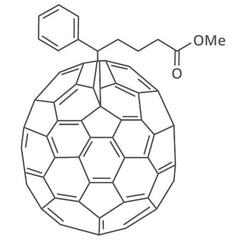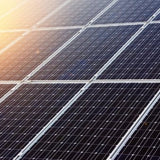PC70BM (C70-PCBM), PC71BM
CAS Number 609771-63-3
Fullerenes for Photovoltaics and Biotechnology, MaterialsFullerene Electron Acceptor Used in Efficient OPV Devices
High purity and available online for fast, secure dispatch
Specifications | Pricing and Options | MSDS | Literature and Reviews
PC70BM ([6,6]-Phenyl-C71-butyric acid methyl ester, CAS number 609771-63-3) is a fullerene electron acceptor commonly used in the most efficient organic photovoltaic devices. The non-symmetrical C70 cage of PC70BM enables energetic transitions that are forbidden in C60, improving the absorption characteristics over PCBM for the visible range of the solar spectrum [1]. This allows increased photon harvesting, and a potentially higher photocurrent for devices using PC70BM rather than PC60BM. The 95% purity PC70BM is recommended for general applications, and has produced power conversion efficiencies of over 9% in our own laboratories when mixed with a low bandgap polymeric donor, while the 99% PC70BM is recommended where ultimate performance is required.
Soluble Fullerene Acceptor
Efficienct charge transfer & excitation dissociation
High Purity
>99% purity
Improves Absorption Characteristics
In the visible light range
Worldwide Shipping
Quick and reliable shipping
PC70BM from Ossila was used in the high-impact paper (IF 29.37), ll-Inkjet-Printed, All-Air-Processed Solar Cells, S. Jung et al., Adv. Energy Mater., 1400432 (2014); DOI: 10.1002/aenm.201400432.
The energy levels and good electron mobility of PC70BM enable it to be used as an electron transport layer in perovskite solar cells. In our laboratories, we have achieved a PCE approaching 12% using PC70BM in CH3NH3PbI3-xClx perovskite solar cells (more details can be found in fabrication guide). When fabricating devices, processing and handling materials in a glove box helps maintain their purity and maintain efficiency by avoiding contamination from particulates, moisture, and airborne impurities.
General Information
| CAS Number | 609771-63-3 |
|---|---|
| Chemical Formula | C82H14O2 |
| Full Name | [6,6]-Phenyl-C71-butyric acid methyl ester |
| Molecular Weight | 1031 g/mol |
| HOMO / LUMO | HOMO = -5.9 eV, LUMO = -3.9 eV |
| Synonyms | C70 PCBM, PC71BM, [70]PCBM |
| Classification / Family | Fullerenes, Organic semiconducting materials, Organic Photovoltaics, Polymer Solar Cells, Perovskite Solar cells, Electron transport layer materials |
Chemical Structure

Pricing
The percentages in the table below represent the ratio of PC70BM to PCBM in the product (i.e. 95% PC70BM with 5% PC60BM).
| Code | Purity | Quantity | Price |
|---|---|---|---|
| M114 | >99% | 100 mg | £220 |
| M114 | >99% | 250 mg | £490 |
| M114 | >99% | 500 mg | £930 |
| M114 | >99% | 1 g | £1730 |
MSDS Documentation
Learn More
 Polymer-Fullerene Bulk Heterojunction Solar Cells
Polymer-Fullerene Bulk Heterojunction Solar Cells
Polymer-fullerene bulk heterojunction (BHJ) solar cells are based on blends of semiconducting polymers and fullerene derivatives, such as PCBM. It is described as a bulk heterojunction as it involves a blend of two materials with differing energy band gaps, forming a dispersed, interpenetrating network.
Read more...Literature and Reviews
- Influence of PC60BM or PC70BM as electron acceptor on the performance of polymer solar cells, F. Zhang et al., Sol. Energy Mater. Sol. Cells, 97 (2012), 71–77; DOI: 10.1016/j.solmat.2011.09.006.
- Efficient planar heterojunction mixed-halide perovskite solar cells deposited via spray-deposition, A. T. Barrows et al., Energy Environ. Sci., 7 (2014), 2944–2950; DOI: 10.1039/C4EE01546K.
